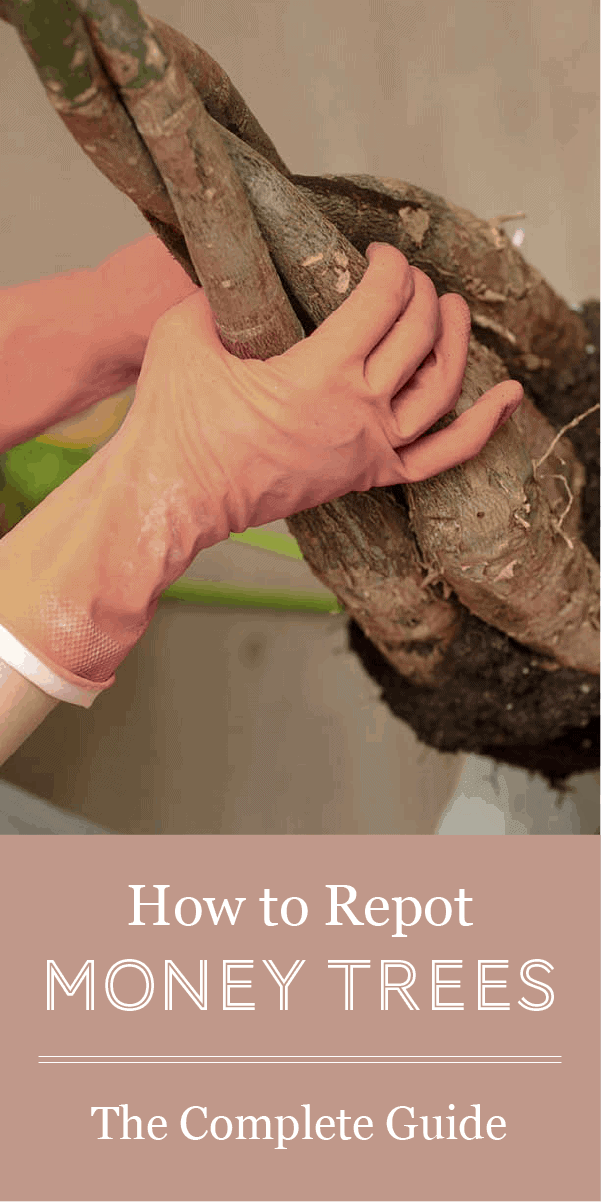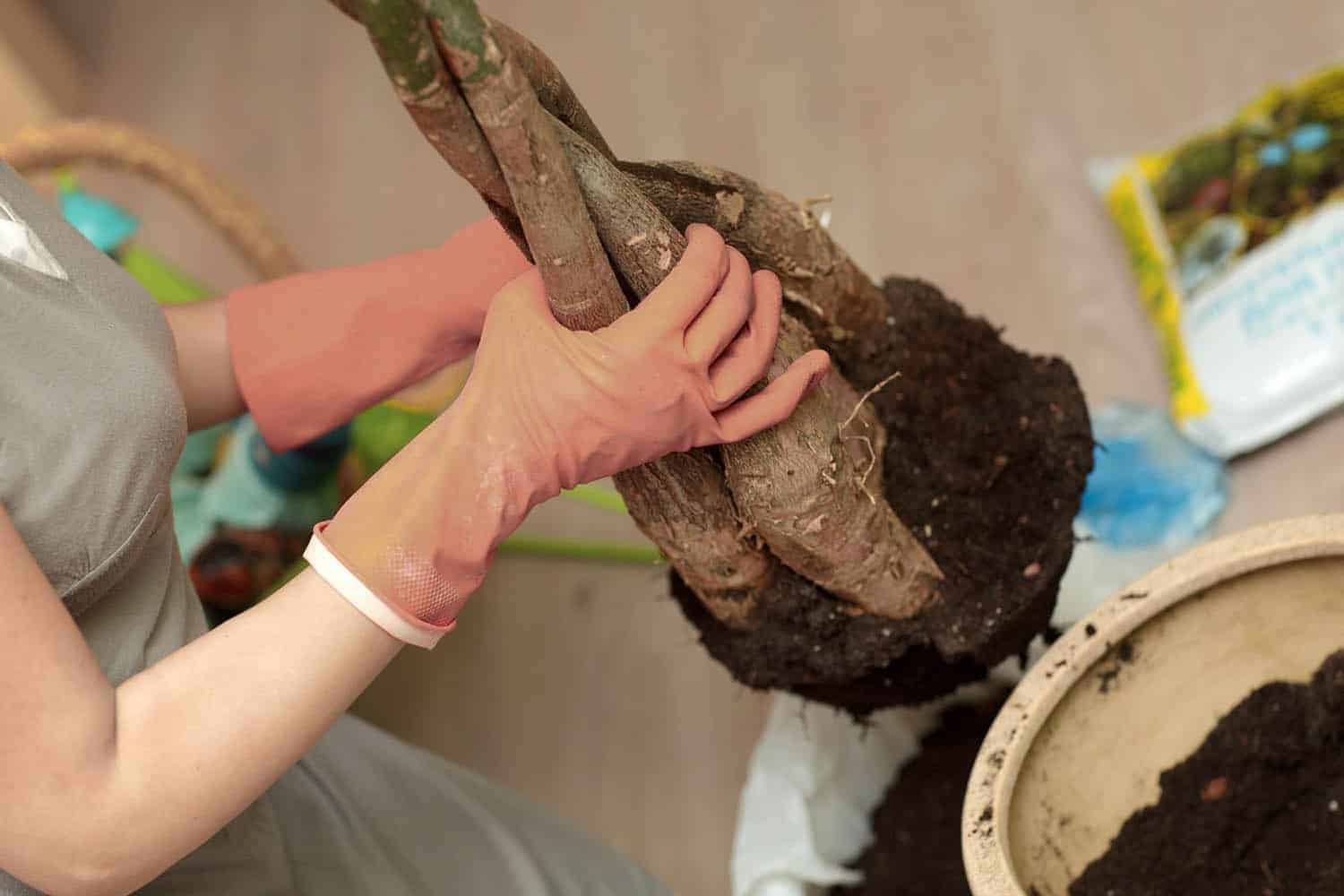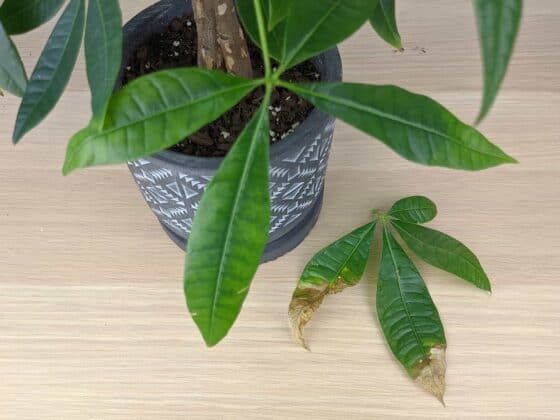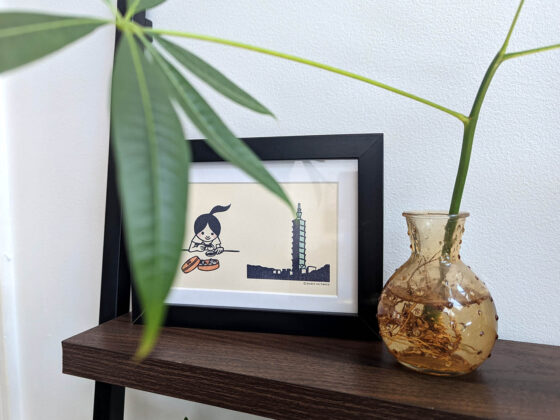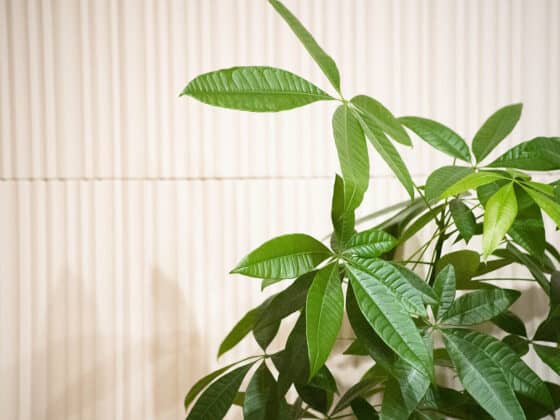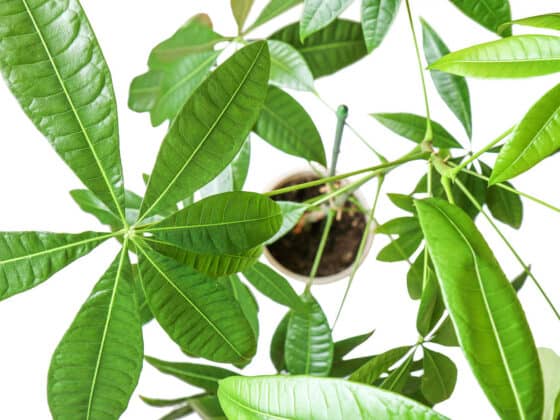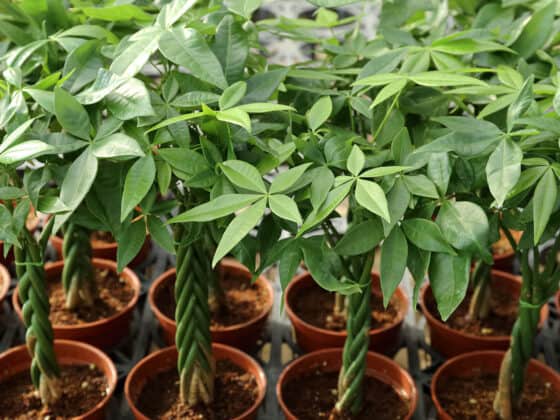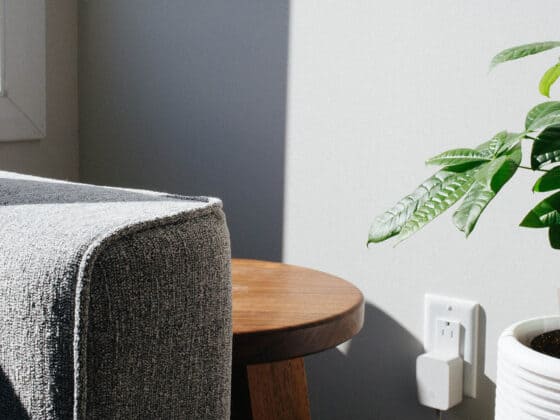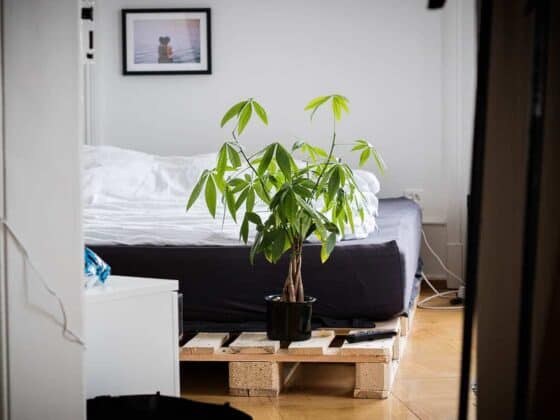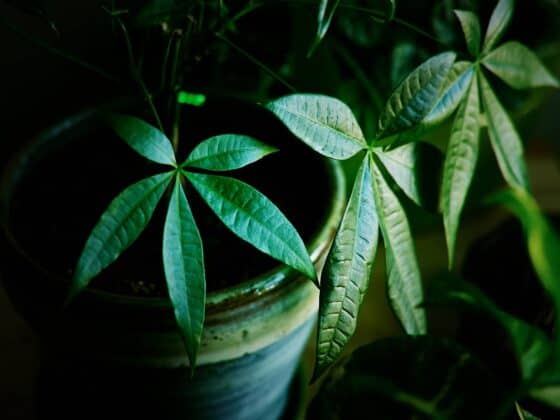Repotting a Money Tree can be a daunting task. These ornamental trees, native to the swamps of Central and South America, require well-draining soil and specific light conditions and can grow to heights of 6 to 8 feet indoors. With a plant that large, you may have a lot of questions when it comes time to transplant it.
How do you repot a Money Tree? Money Trees should be replanted in spring or early summer and given a slightly larger pot with fresh soil. This will give the plant plenty of room and nutrients to help it expand during its upcoming growing season.
While they aren’t necessarily sensitive, Money Trees can experience shock from being transplanted. So, how can you minimize that risk, when should you replant, and what kind of pot and soil does your Money Tree need? Keep reading to learn everything you need to know to successfully repot and care for a Money Tree.
Why Do Money Trees Need To Be Repotted
Almost all plants need to be repotted at some point in their lives, and Money Trees are no different. There are a variety of reasons that plants need to be transplanted.
Sometimes it’s a matter of taste. Perhaps have found a new planter that will better suit your decor, or that would look great with your finished home renovation, and you want to transplant your Money Tree.
Other times, your tree has outgrown its current container and needs to be moved up a size. In these cases, you can decide whether you want to let it keep growing bigger and bigger or cut back the roots and keep it on the small side. The size of the container you choose will directly affect that outcome.
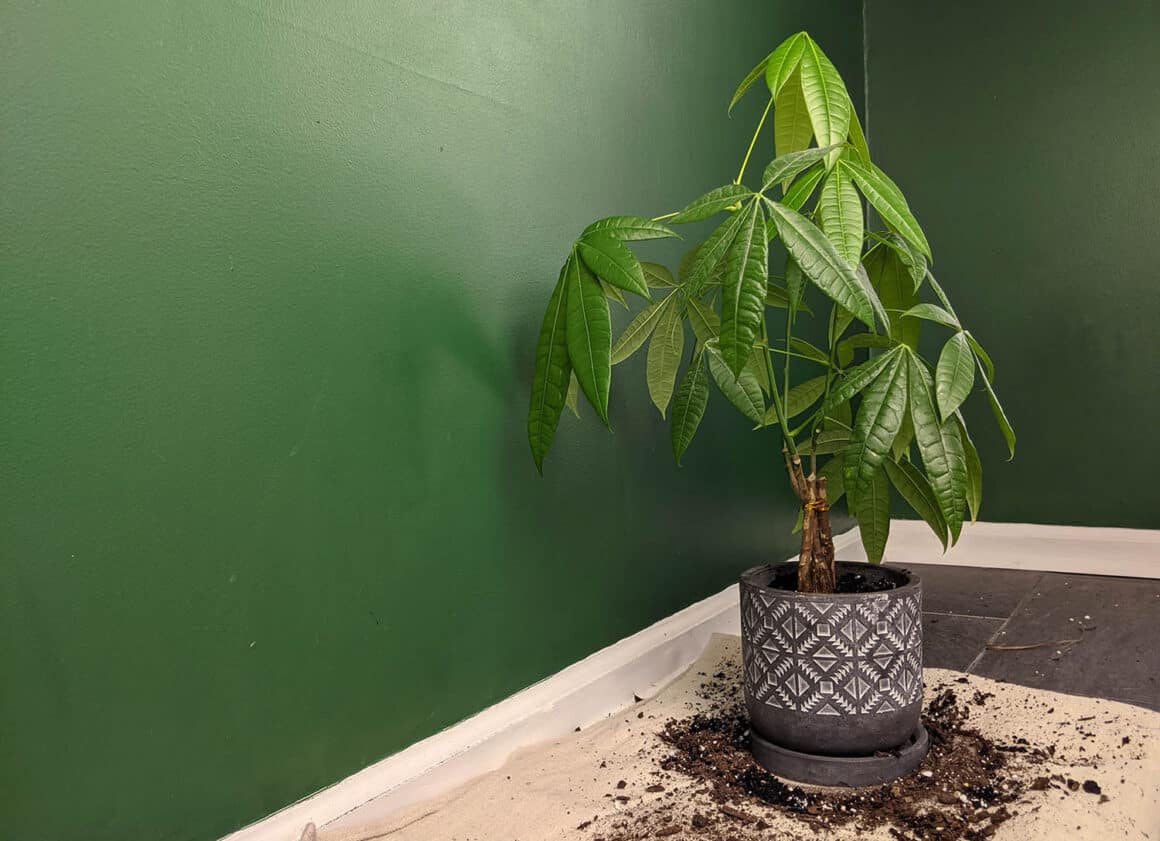
Another reason for repotting your Money Tree is that it needs a refresh of soil to replenish the nutrients available to it. Potting soil is fortified with nutrients, but after six months to a year, the plant has depleted the soil. If you haven’t noticed any new growth and know your Money Tree isn’t dormant, it may have simply run out of the vital ingredients that help it grow. Replacing the soil and putting it in a larger pot can encourage growth and allow your Money Tree to thrive.
If your Money Tree has experienced root rot or pest infestations, you will also want to repot it. Root rot can cause serious damage to your Money Tree. Any infection, regardless of how minor it is, requires that the soil be replaced and the pot properly sanitized. Not doing so can result in recurring outbreaks.
The same goes for pests. If you have had a case of spider mites, brown scale, or mealybugs, you’ll need to replant your Money Tree in fresh soil. The eggs for these insects can continue to hatch even after you’ve eliminated the fully-grown bugs, so fresh soil and sanitization are key to preventing repeat outbreaks.
If you’ve noticed water immediately runs out of the pot when you water your Money Tree, that’s the last indicator that it may be time to repot your plant. This often happens when a plant has become root-bound. Being root bound won’t necessarily kill a Money Tree, but it will prevent it from taking up nutrients and water properly. Being in this state will prevent the plant from continuing to grow, leaving you with a Money Tree at the maximum height it can reach in its current container.
How Often Do Money Trees Need Transplanting
In general, Money Trees should be repotted every two years. Many plants prefer replanting every year, but Money Trees do best when allowed to grow in their planter for a longer time.
Part of this is because repotting is a stressful event for plants. They can suffer from transplant shock, which happens when a plant is moved from one pot to another. Indications of transplantation shock include drooping leaves or branches that can, over time, result in leaf yellowing and eventual loss.
Repotting your Money Tree less frequently can help prevent this and allows your tree to become comfortable in its current pot, which will promote growth. Less frequent replanting also means fewer opportunities for things to go wrong, like potentially introducing a pest or contaminant from tainted soil.
Two years isn’t a rule, though. A well-cared-for Money Tree that has reached a good height can be left in its pot for longer. The only concern at that point should be nutrient depletion in the soil. This can be remedied with proper fertilization or by merely refreshing the top layer of soil.
Do Money Trees Like To Be Root Bound
There are some misconceptions about how Money Trees prefer to be kept. The fact is that few plants prefer to be root bound, regardless of what type they are. There are many plants, including Money Trees, that can tolerate being root bound, but that isn’t necessarily a comfortable way for them to live.
Being root bound not only stunts growth but also prevents water and nutrient absorption. Once a plant has become root bound, there is very little room in its planter for soil. This means that water will almost immediately drain out. This prevents your Money Tree from properly taking in water, which can dehydrate it and result in leaf yellowing and loss. Part of the purpose of soil is to keep the plant hydrated!
If you’ve noticed that your Money Tree is root-bound and you’re concerned about it, take extra care when repotting. It is much easier to damage roots that are tightly intertwined because they will require being untangled a little bit before being put into their new pot.
Plant owners sometimes believe that allowing your Money Tree to become root-bound is the only way to prevent it from continuing to grow, but that is a misconception. Money Trees kept indoors can typically reach a maximum height of 8 feet. If you prefer to keep your tree on a desk or counter, you can minimize the amount of new growth by regularly pruning the stems and leaves and periodically trimming back the roots. For more information on keeping a Money Tree small, click here.
Choosing The Best Soil For Money Trees
Despite being from swampy regions, Money Trees are sensitive to their soil’s water content. This makes choosing the right soil very important in their upkeep.
Ideally, the soil that you choose for your Money Tree should be fast-draining so that the plant doesn’t retain excess water and can dry out quickly between waterings. Money Trees that are continually in wet soil are quick to develop root rot, which will send your plant to an early grave.
It can be challenging to find the perfect soil for Money Trees in stores, especially if you don’t have access to a reputable nursery. For that reason, I often blend my own quick-draining soil mixture. Regular store-bought potting mix can be mixed with Cactus or Succulent blends and perlite, pumice, or sand to increase drainage.
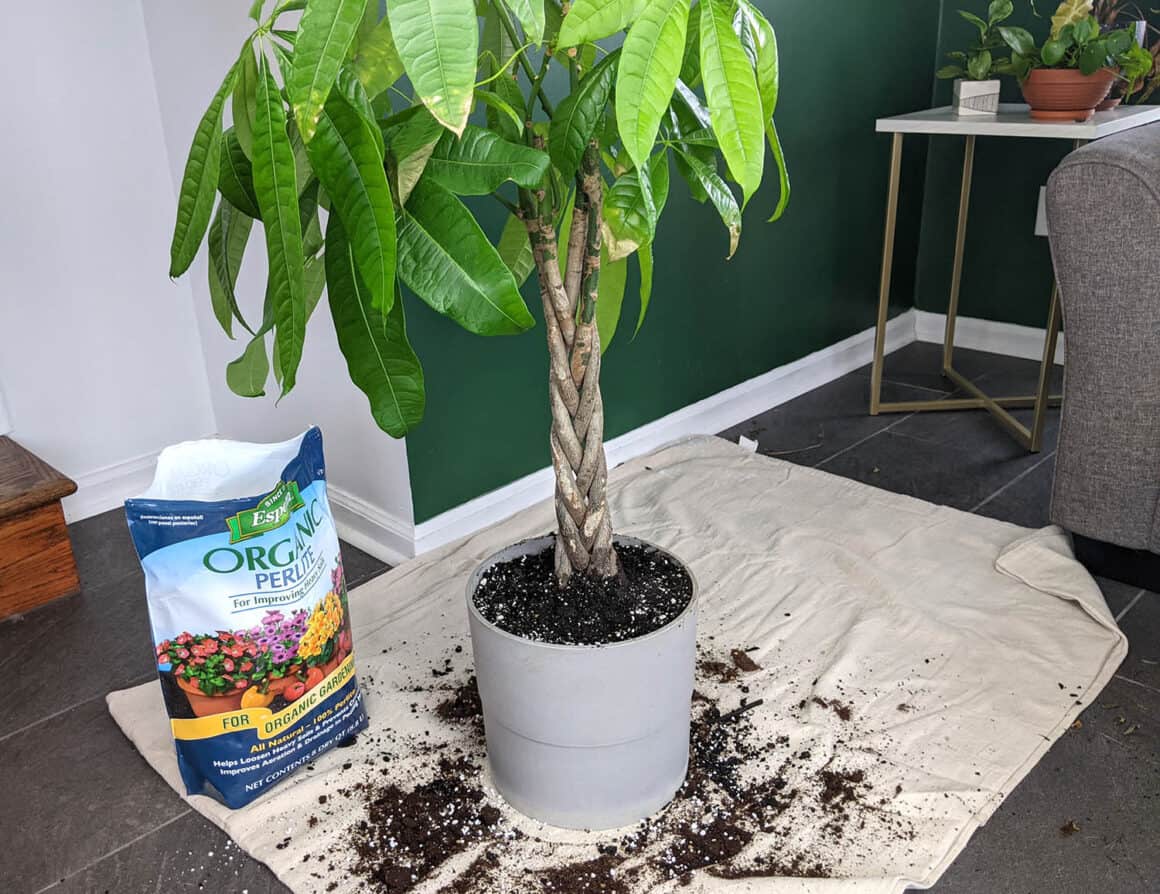
Perlite is an additive in lots of potting soil recipes. It is a mined volcanic rock that expands when heated, making it look like a small white styrofoam ball. When added to potting soil, perlite helps to improve the drainage of the mix.
Pumice is similar to perlite. It is also a mined volcanic rock and behaves similarly when mixed into potting soil. However, because it is heavier than perlite, it will not rise to the top of the mix after watering like perlite often does.
Sand is important because it helps even more with drainage. Sand won’t retain water as much as other soil additives, which is key to a healthy Money Tree. It also creates small pockets of air in the soil, which will encourage root growth.
Good drainage is one of the most essential parts of Money Tree care. Sand or perlite mixed with peat moss creates the perfect combination to encourage growth, help nutrient-absorption, and prevent root rot.
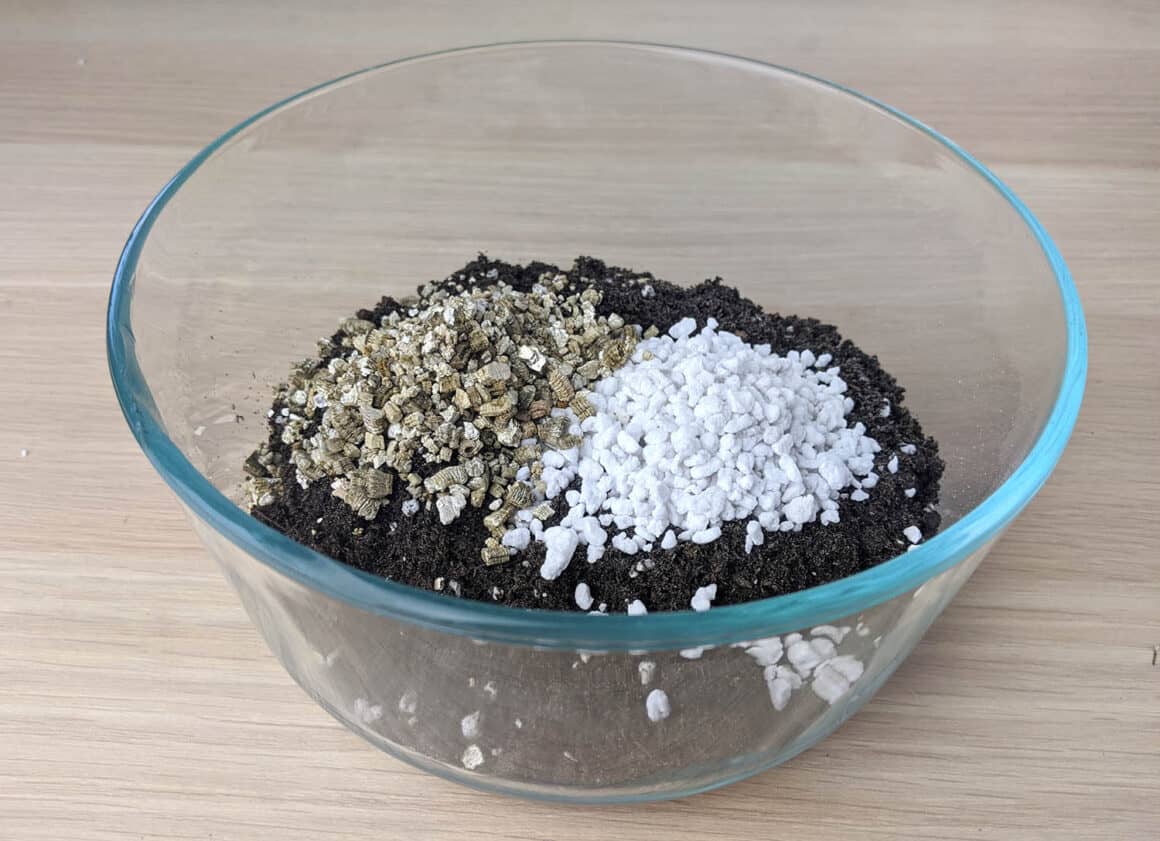
While there’s no hard-and-fast recipe for the perfect potting mix, the guideline for the mixture should be somewhere near 2:1:1, with two parts of potting mix, one part of peat moss, and one part perlite or sand. Or one part potting mix to one part succulent or cactus blend.
Be sure to feel the soil when you’ve finished mixing; if you notice that there seems to be too much sand or peat moss, add potting mix accordingly. If you’re looking for more information on Money Tree soil, read this article.
What Containers Are Best For Money Trees
There are a lot of different types of containers on the market: terra-cotta, plastic, ceramic, wooden… the list goes on and on. It’s sometimes hard to pick out which one is right for your plant.
Clay or terra cotta pots are an excellent choice for Money Tree owners who tend to overwater their plants. Terra cotta is porous, which helps to pull excess moisture from the soil after waterings and can work to prevent root rot.
You should note, in less humid homes, these planters may dry out too quickly, which can stunt a Money Tree’s growth. If you forget to water your plants from time to time, terra cotta isn’t the right choice for you.
Plastic containers are another option for Money Trees. They’re lightweight, making them easy to move, and they retain water well. Plastic pots are also much less likely to break than their clay or ceramic counterparts, which is great for pets, kids, or clumsy plant owners.
Ceramic pots are another good choice for Money Trees. These are similar to clay planters but with a special glaze that makes them glossy and helps with water retention, a better choice for anyone who forgets to water their Money Tree regularly. Because of the glaze, the water will evaporate much slower from the soil, which will help keep your Money Tree’s roots moist. You won’t need to water as often in ceramic or plastic pots, so be careful to check your plant’s moisture level before watering again.
What Size Container Does A Money Tree Need
One of the most common problems that plant owners encounter when it comes to replanting their Money Tree is getting the right size pot. Choosing the right size planter depends on the needs of the plant.
If your Money Tree has become root-bound or you want to encourage growth, it’s important to get a slightly larger pot. The general rule is to choose a planter that is 1 to 2 inches bigger in diameter than the pot your Money Tree is currently residing in.
Choosing too large of a planter can be detrimental to your plant’s health. It may seem like this is the way to go— after all, more room in the pot means more room for the roots to grow, right? The problem is that pots that are too big tend to retain far more moisture than a plant’s roots can absorb. This moisture can take much longer to evaporate than it would in a smaller pot, creating a breeding ground for root rot.
Choosing a planter that is too small, however, can bring problems of its own. You probably won’t be able to fit your Money Tree into a smaller pot than the one it was initially in, especially if your Money Tree has become root-bound. But if you can somehow squeeze it in, it won’t continue to grow.
If your goal is to prevent new growth and keep your Money Tree at its current size, you should plan to provide a combination of pruning the leaves and stems regularly and trimming the roots back periodically. Doing so will keep your Money Tree the size that you like without preventing it from being able to absorb water and nutrients. Keeping it in a pot that it has outgrown will keep it small but won’t keep it healthy.
How to Remove Your Money Tree From Its Container
Removing your Money Tree to replant it should be done very carefully. Being too rough can damage the roots, stems, or leaves, resulting in transplant shock. Transplant shock, which can affect any type of plant, can cause your Money Tree to look unhealthy and unhappy.
To properly remove a Money Tree, water it a day or two before you plan to transplant it. This makes it easier to remove from its old potting mix and ensures that the plant is healthy before transplanting.
When you’re ready to transplant, lightly grasp the base of the Money Tree, close to the soil, with your thumb and first two fingers. Hold the pot with your other hand and turn it upside down; the plant should slide out on its own. If it doesn’t, don’t tug on the trunk! This can seriously hurt your Money Tree. Instead, run a butter knife along the inside rim of the pot to help your plant release its grip before trying again.
For larger Money Trees that can’t be lifted, get help turning the pot on its side and sliding it out. If it doesn’t budge, gently dig a little of the soil out until the Money Tree can safely be removed. Once you’ve removed the Money Tree, carefully break up the root ball and shake the old soil from it. Inspect the roots for any signs of root rot or entanglement.
Roots that are mushy and brown are indicative of root rot. Any roots that look like this can be pruned away. To do so, use sterilized scissors or a knife and gently snip the affected roots. Clean your tool between each cut to prevent cross-contamination that can potentially spread to healthy roots.
If the Money Tree’s roots are seriously tangled, carefully unravel them with your fingers. Don’t yank apart roots that don’t want to come apart. This can damage the plant and is far worse than some of the roots being tangled together.
How To Transplant Money Trees
Once your plant is removed from the planter, and you’ve found the new pot and soil you want to use, transplanting is simple. To get started, lay down newspaper or a canvas tarp to avoid having to clean up a huge mess. Set out your fresh pot, clean scissors, prepared soil, and your Money Tree.
If your new pot has too large of a drainage hole, which can cause the soil to flush out when watering, lay a coffee filter, a few rocks, or a small piece of screen over. But be careful not to block or stop up the drainage hole. Drainage is vital in healthy Money Trees.
Put a small layer of the prepared potting mix in the bottom of the pot, filling about the bottom inch of the planter. The Money Tree’s rootball should then be placed in the center of the new pot. Add the prepared potting mixture evenly to all sides of the plant until the Money Tree’s rootball sits about an inch beneath the planter’s rim. Gently press the soil into the pot, being careful not to pack it too tightly.
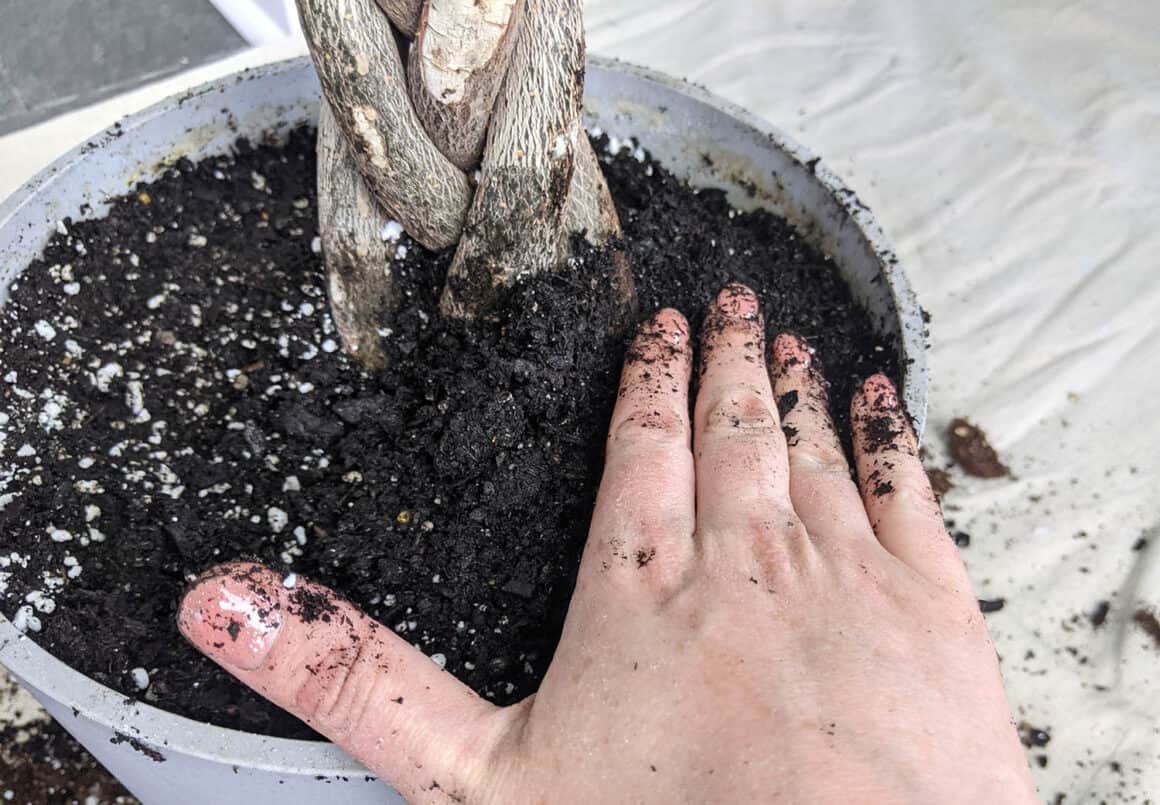
After you’ve finished this, water the Money Tree until the water runs out of the bottom. Pour out any water that collects in its saucer. Put the plant back in its usual area and continue to care for it the way that you did before.
Always keep an eye out for indications that the plant isn’t draining properly, such as overly moist soil, yellowing or browning leaves, or a mushy trunk. These are indications that the Money Tree may be developing root rot.
When Is The Best Time To Repot A Money Tree
There are certain times of the year when Money Trees respond better to transplanting. Timing your Money Tree replanting for certain seasons will help minimize the risk of transplant shock.
Ideally, a Money Tree should be repotted in spring or early summer. This is the time of year that plants are beginning to wake up from their dormant stage. Repotting your Money Tree at this point will encourage growth for the duration of their growing period by giving them access to fresh nutrients and more space in their pots.
If, for some reason, your Money Tree has to be repotted in the dead of winter, be diligent in caring for it afterward and be sure that it has the same conditions that it did before repotting. This will help minimize the risk of transplant shock.
Caring For Your Newly Transplanted Money Tree
After transplanting your Money Tree, you should care for it the same way that you did before. Put it back in its original location, where it is used to the light conditions, humidity, and any drafts. Continue your original watering schedule. Minimizing the number of changes that your Money Tree has to go through will make the likelihood of success much higher.
Replanting A Money Tree
Replanting a Money Tree can be a daunting task. Taking the right precautions, researching, and adequately preparing, can make the process run much smoother.
Be sure to repot with the proper supplies. Picking the right type of planter can make all the difference, so keep that in mind if you need to go shopping for a new pot. Your Money Tree also needs well-draining soil, which can be purchased at a store or mixed at home.
Try to transplant your Money Tree during spring and early summer, before entering their growth period so that they have plenty of room to expand their roots and easy access to lots of fresh nutrients.
After replanting, watch your Money Tree for any indications that it’s experiencing transplant stress. To minimize the risk that your Money Tree might respond poorly to being replanted, be sure to put it back in its original location and provide it the same care that it had before.
